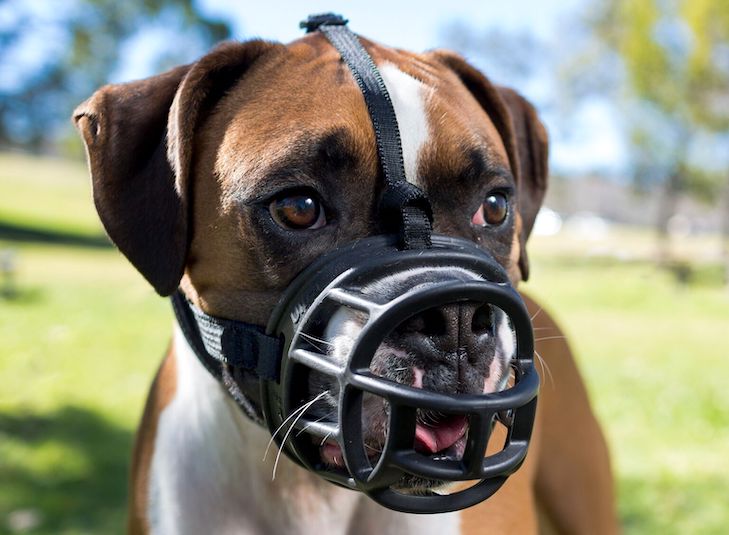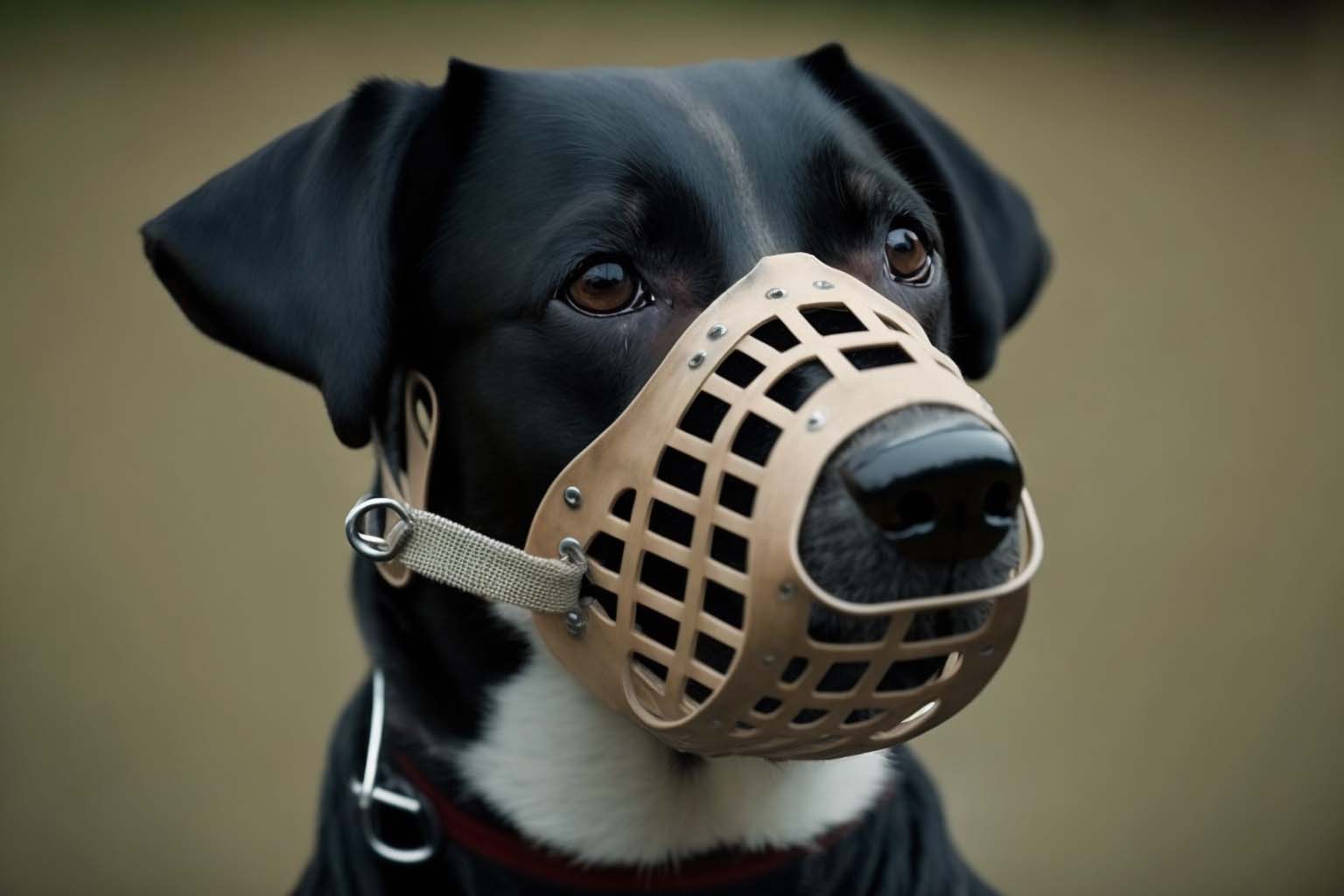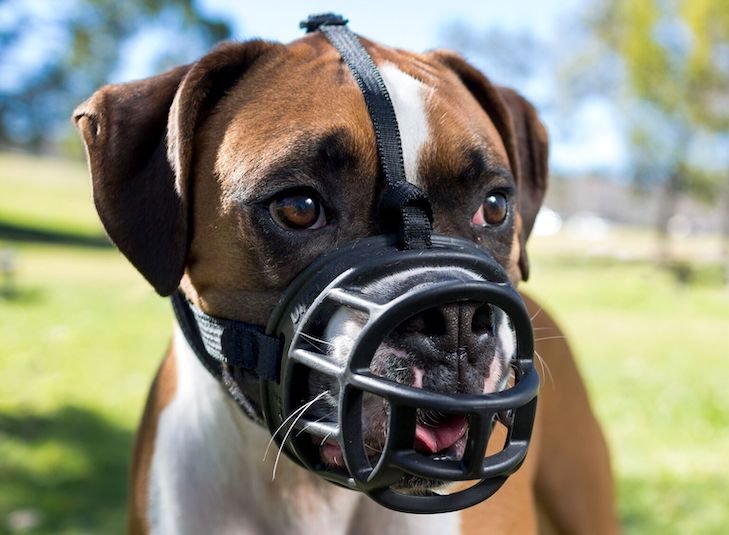You should use a dog muzzle when a dog is injured or in a threatening situation, as even friendly dogs can become fearful and aggressive. It’s important to note that not all muzzled dogs are dangerous or at risk of biting.
Introducing a muzzle can also be helpful when introducing two dogs to prevent physical injuries during interactions. However, it is not recommended to leave a dog muzzled while unattended or overnight. Muzzles should be used as a temporary solution in specific situations and should not be relied upon as a long-term solution for behavioral issues.
Why Use A Muzzle?
Muzzles are not just for aggressive dogs. Even the friendliest of dogs can become fearful or aggressive when injured or in a threatening situation. A muzzle serves as a safety precaution for dogs and their owners by reducing the risk of biting incidents and managing dogs in stressful situations.
Safety Precaution For Aggressive Or Fearful Dogs
A muzzle provides a safety net for aggressive or fearful dogs. It acts as a barrier that prevents them from lashing out at people or other animals when they feel threatened or scared. By using a muzzle in these situations, you can ensure the safety of everyone involved.
Reducing The Risk Of Biting Incidents
One of the main reasons to use a muzzle is to minimize the risk of biting incidents. Whether you have an unpredictable dog or you are in a public setting where your dog may feel overwhelmed, a muzzle can give you peace of mind knowing that your dog cannot harm others.
Managing Dogs In Stressful Situations
Stressful situations, such as visits to the vet or groomer, can trigger anxiety or panic in dogs. A muzzle can help manage their behavior and keep everyone safe during these events. It prevents them from biting or nipping out of fear or discomfort.
Overall, a muzzle is a vital tool in ensuring the safety and well-being of your dog, as well as those around them. It can prevent potential harm in situations where a dog may act out due to fear, aggression, or stress. By using a muzzle responsibly, you can help create a more secure and controlled environment for both yourself and your four-legged friend.

Credit: companyofanimals.com
When To Remove The Muzzle
Muzzles should be used on dogs when they are injured or in threatening situations, as even friendly dogs can become fearful and aggressive. It is important to note that not every muzzled dog is dangerous, and muzzles can be used to prevent biting.
e is a bite risk. Muzzles can also be used to prevent scavenging, barking, or excessive licking. Deciding factors for muzzle removal: 1. Monitoring dog behavior: Keeping a close eye on your dog’s behavior is crucial when deciding whether or not to remove the muzzle. Look for signs of distress, anxiety, or aggression. If your dog is displaying calm behavior and seems comfortable wearing the muzzle, you can consider removing it. 2. Gradual transition without the muzzle: Once you’ve assessed that it’s safe to remove the muzzle, it’s important to make a gradual transition. Start by removing the muzzle for short periods of time in a controlled and familiar environment. Observe your dog’s behavior during these times and ensure they remain calm and well-behaved. 3. Checking for any negative reactions: While allowing your dog to be without a muzzle, carefully observe their reactions and interactions with people and other animals. If your dog shows any signs of aggression or discomfort, it may be necessary to continue using the muzzle in certain situations. 4. Gather feedback from professionals: Consulting with professional dog trainers or behaviorists can provide valuable insight into when it is appropriate to remove the muzzle. These experts can evaluate your dog’s progress and offer guidance in making the safest decisions for your furry friend. By following these deciding factors, you can make an informed judgment about when to remove your dog’s muzzle. Remember, the safety and well-being of your dog and those around them should always be the top priority.Different Types Of Muzzles
When it comes to using a muzzle for your dog, it’s important to choose the right type that suits your dog’s needs and comfort. Muzzles are not only used to prevent biting but also to keep your dog and others safe in various situations. Let’s explore different types of muzzles:
Kloss Muzzle
The Kloss muzzle is a popular choice for dogs who need to wear a muzzle for extended periods. It is made of durable material that allows for easy breathing and panting. The Kloss muzzle also has adjustable straps for a secure and comfortable fit.
Basket Muzzles
Basket muzzles are another commonly used type of muzzle. These muzzles are designed to allow your dog to pant, drink water, and take treats while wearing them. The basket design also provides more room for your dog’s snout, which is important for their comfort.
Comparing Features Of Different Muzzles
When choosing a muzzle for your dog, it’s important to compare the features of different options available. Here is a comparison of some common features:
| Muzzle Type | Material | Breathability | Adjustability |
|---|---|---|---|
| Kloss muzzle | Durable | High | Yes |
| Basket muzzle | Variety of materials | High | Yes |
- Kloss muzzle: Made of durable material, provides high breathability and adjustable straps for a secure fit.
- Basket muzzle: Available in a variety of materials, offers high breathability and adjustable straps for a comfortable fit.
By considering these features, you can select the muzzle that best suits your dog’s needs and ensures their comfort while wearing it. Remember, muzzles should never be used as a substitute for proper training and socialization. When used correctly, muzzles can be a valuable tool to keep both your dog and others safe in various situations.
Acclimating Your Dog To A Muzzle
When it comes to acclimating your dog to a muzzle, it is crucial to take a gradual approach. Rushing the process can lead to fear and anxiety in your dog, making it difficult for them to accept and wear the muzzle comfortably. By taking things slow and allowing your dog to become familiar with the muzzle at their own pace, you can ensure a positive and stress-free experience.
Forcing a muzzle on your dog without proper training can be counterproductive and may even result in fear-based aggression towards the muzzle or people handling it. It is important to remember that the goal is to create a positive association with the muzzle, not to simply strap it on and hope for the best.
When selecting a muzzle for your dog, it is crucial to choose the right type and size to ensure proper fit and comfort. Muzzles come in various styles, such as basket muzzles or Kloss muzzles, each designed for different purposes and dog breeds.
A basket muzzle is a popular choice as it allows your dog to pant, drink, and take treats while wearing it, providing them with the ability to engage in natural behaviors. It is important to select a muzzle that fits snugly but does not restrict your dog’s breathing or movement.
Refer to the manufacturer’s sizing guide to ensure you choose the correct size for your dog’s breed and muzzle dimensions. Remember, a properly fitted muzzle should allow your dog to open their mouth slightly.
To successfully acclimate your dog to a muzzle, positive reinforcement techniques are essential. These techniques involve rewarding your dog for any positive interaction with the muzzle, helping them associate it with positive experiences.
Here are some steps to follow during the acclimation process:
- Start by introducing the muzzle to your dog in a comfortable and familiar environment.
- Allow your dog to approach the muzzle voluntarily and sniff it.
- Reward your dog with treats and praise for any interaction with the muzzle, such as touching it with their nose or paw.
- Slowly progress to touching the muzzle to your dog’s face, rewarding them for remaining calm and relaxed.
- Gradually increase the duration of muzzle exposure, always rewarding positive behavior.
- Practice fastening and unfastening the muzzle straps without restricting your dog’s movement.
- Finally, encourage your dog to wear the muzzle for short periods, gradually increasing the duration over time.
Remember to be patient and consistent throughout the acclimation process. Each dog is unique, and the length of time it takes for them to feel comfortable wearing a muzzle may vary. By using positive reinforcement techniques, you can ensure a positive association with the muzzle and help your dog feel relaxed and secure while wearing it.
Tips For Using Dog Muzzles Effectively
Looking to effectively use a dog muzzle? Muzzles are not just for aggressive dogs; they can also be useful for preventing biting in fearful or injured dogs. Knowing when and how to use a muzzle can help keep both your dog and others safe.
Properly Buckling The Muzzle
When it comes to using a dog muzzle, it is essential to properly buckle it to ensure the safety and comfort of your furry friend. To buckle the muzzle correctly:
- Hold the muzzle in front of your dog’s face, making sure the straps are facing upwards.
- Slide the loop of the muzzle over your dog’s nose, ensuring that it fits comfortably.
- Take the straps and secure them behind your dog’s ears.
- Check if the fit is snug, but not too tight, allowing your dog to open their mouth slightly.
Applying The Muzzle Safely
Applying a dog muzzle safely is crucial to prevent any discomfort or harm to your pet. Follow these steps for a safe application:
- Introduce the muzzle to your dog gradually, allowing them to sniff and investigate it at their own pace.
- Offer treats or rewards when your dog interacts positively with the muzzle, slowly associating it with a positive experience.
- Gently place the muzzle on your dog’s nose and hold it in place with one hand.
- Use your other hand to fasten the straps securely behind your dog’s ears, ensuring a proper fit.
- Check for any signs of discomfort, such as excessive pawing or rubbing, and readjust if necessary.
Monitoring Your Dog’s Comfort And Behavior
Once the muzzle is properly applied, it is crucial to continuously monitor your dog’s comfort and behavior. Remember the following tips:
- Regularly check the fit of the muzzle, ensuring that it is not too tight or causing any discomfort.
- Observe your dog’s behavior for signs of distress or anxiety, such as excessive panting or pacing.
- Ensure your dog has access to water and can pant comfortably while wearing the muzzle.
- Gradually increase the duration of muzzle-wearing sessions, giving your dog time to adjust and feel more comfortable.
- If your dog shows signs of extreme discomfort or distress, remove the muzzle immediately and consult with a professional trainer or veterinarian.

Credit: www.akc.org

Credit: k9aggression.com
Frequently Asked Questions For Dog Muzzles: How And When To Use One
When Should You Put A Muzzle On A Dog?
Muzzles should be used when a dog is injured, in a threatening situation, or showing aggressive behavior. While muzzles are often used to prevent biting, not all muzzled dogs are dangerous. It is important to note that muzzles should not be left on a dog unattended or overnight to avoid potential injuries.
How Many Hours A Day Can A Dog Wear A Muzzle?
A dog should only wear a muzzle for short periods of time, typically no more than 1-2 hours a day. It is important to supervise the dog while it’s wearing a muzzle and never leave it on unattended or overnight.
Muzzles should only be used in specific situations for the dog’s safety.
Should I Put A Muzzle On My Dog To Meet Other Dogs?
To meet other dogs, it may be beneficial to introduce a muzzle to your dog to prevent physical harm. Muzzling doesn’t necessarily mean a dog is aggressive. However, it is important not to leave a muzzle on your dog overnight or when they are unattended as it can be dangerous.
Is It Bad To Leave A Muzzle On A Dog Overnight?
Leaving a muzzle on a dog overnight is not recommended. It can lead to injury as the dog may try to remove it on its own. Muzzles should only be used under supervision and for short periods of time when necessary.
Conclusion
Dog muzzles can be a valuable tool in certain situations, but it’s important to use them appropriately. Muzzles are not just for aggressive dogs; they can also be used to prevent a friendly dog from biting when injured or scared.
It’s essential to properly introduce and acclimate your dog to wearing a muzzle for their comfort and safety. Remember, a muzzle is not a long-term solution and should only be used in specific circumstances. By following these guidelines, you can ensure the effective and responsible use of a dog muzzle.







